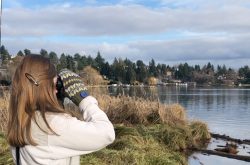
Where do birds go during the colder months? Do we see different species of birds here in Seattle during the winter versus during the summer? Where are the best spots to catch a glimpse of birds? Luckily for bird enthusiasts, winter in the Pacific Northwest is just as great for bird watching as summer, but with some key differences. Olivia Sanderfoot, who recently defended her Ph.D. in the UW School of Environmental and Forest Sciences guides us on what to expect when birding in the winter and fills us in on her favorite places to observe her feathered friends.
A flock of their own
In the summertime, birdwatchers can expect to see a lot of migrants passing through the Pacific Northwest, resulting in a stunning array of species that are engaged in breeding activity. A different set of species inhabit the Pacific Northwest in the winter: species that breed in the Arctic, resident species, and large flocks of waterbirds like herons and cormorants. Birders hoping to find species like scoters and redpolls that breed in the Arctic and escape the harsh winters by migrating south to seek warmth will only see them in the wintertime.
Birders hoping to see a wide variety of birds should head to a location that offers a wide range of habitats, such as the Center for Urban Horticulture or Discovery Park here in Seattle. Different habitats support different species, so these places allow birdwatchers to see and hear a lot of species in a short amount of time. Sanderfoot also recommends checking out shores and coastlines to observe big rafts of mixed flocks with waterfowl wintering in Seattle.
Birding at home
For birders who prefer to stick closer to home, Sanderfoot encourages the use of bird feeders in backyards to attract both migratory and resident species. She notes that hummingbird feeders may have allowed some local hummingbirds to expand their range northward, which highlights one of many ways humans create and alter bird habitat in urban areas.
For those worried about birds becoming dependent upon bird feeders for survival, Sanderfoot offers reassurance. “Birds will not become dependent on your feeders,” she says. “If you decide to take down the feeder, you don’t need to worry that a bird is not going to be able to find something to eat — they are very good at foraging on their own for food.” In fact, studies have shown that even with bird feeders in play, birds still get about 50% of their food from natural sources. Bird feeders are especially helpful during the toughest, most frigid winter days or during storms, but bird feeders don’t affect the way birds feed day-to-day.
Sanderfoot also stresses the importance of cleaning backyard bird feeders. “You can’t just keep a feeder and expect that it’s a low-maintenance gardening activity,” she says. “You do need to be good about cleaning the feeders because they can spread disease between birds.”
Feeders should be cleaned every couple of weeks, or more often in humid conditions. Here are the steps to cleaning and disinfecting bird feeders:
- Throw away any remaining bird feed, then disassemble the feeder.
- Clean with soap and water. Make sure to scrub the inside so that there’s no remaining feed.
- Soak in a diluted bleach solution for about 10 minutes (9 parts water, 1 part bleach)
- Dry feeder completely before refilling.
Diligently cleaning bird feeders will help prevent the spread of disease among birds. It’s also important to pay attention to local nonprofits’ advice about when to take down bird feeders in the event of a disease outbreak.
Sanderfoot strongly advises against feeding birds while out on a hike or on a neighborhood stroll. “I never hand feed birds,” she says. “In general, I think that is a bad idea because if birds learn to associate food with people, that can lead to greater human-wildlife conflict. Plus, sometimes people feed birds food that’s really not good for them, like bread.”
Where to bird watch
Seattle offers a plethora of amazing locations to go bird watching during the wintertime. Any place with a diversity of habitat will support a diversity of species, allowing viewers to see and hear lots of different birds. Sanderfoot recommends checking out shorelines and wetlands to observe big rafts of mixed flocks, specifically calling out the Center for Urban Horticulture and Discovery Park as her favorite birding locations in Seattle. Outside of Seattle, anywhere along the Washington coast will offer views of sea ducks and other water birds wintering in the Pacific Northwest. So grab your binoculars, bundle up and enjoy all the bird life you’ll find here in the winter months!
View this post on Instagram

